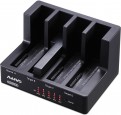Drive form factor
The form factor of the drive that the pocket is designed to hold.
Such accessories are made for standard form factors of internal drives:
3.5 ",
2.5"(often — for both at once), as well as
M.2 SSD. Here are the features of each of these options:
— HDD 3.5 ". 3.5" is the traditional form factor of internal drives for full-size desktop PCs. Accordingly, internal pockets for this form factor are used exclusively in PCs or servers, they are too bulky for laptops; moreover, most of these pockets are a chassis — "sled" (see "Purpose"). External solutions turn out to be more bulky than models under 2.5", however, due to the absence of strict restrictions on the size, capacious drives for such pockets are much cheaper than miniature analogues of the same capacity. Also note that most 3.5-inch drives are just traditional hard drives (or hybrid SSHD devices), SSD modules in this form factor are practically not produced.
SSD or HDD 2.5". Therefore, the internal pockets of this form factor are intended primarily for laptops; a classic version of such an accessory is an adapter for installing a drive in an optical drive slot. In PC models, this option has not received much distribution — modern desktops usually have not only 3.5-inch, but also 2.5-inch drive bays; and for a number of reasons, it is more convenient to use 3.5" solutions as quick-release "
...sleds" (see above). But for servers, internal pockets of this form factor are available — for several slots; they usually also represent a "sled" chassis. What As for external models, 2.5" pockets are noticeably smaller than 3.5" counterparts, however, drives for them are more expensive per gigabyte of capacity (especially with large volumes).
— SSD or HDD 2.5"/3.5". Models designed for two form factors at once. The meaning of this marking depends on the particular type of pocket. So, in external models and docking stations (see "Type"), it usually means the ability to install a drive of any of the two form factors in your pocket, to choose from. Usually, bays or slots in such models are initially designed for 3.5", and special plugs are used to fix 2.5" drives in such slots (note that there may be fewer such plugs in docks than sockets). A similar design is used in internal models for servers, as well as in PC chassis that look like a "sled" (see "Intended use"). However, in PC models there is another option — adapters for accommodating 2.5" HDD / SSD in 3.5" form factor slots ; such accessories are also included in this category.
— SSD M.2. Form factor designed specifically for miniature internal components, including solid state drives. Dimensions of M.2 peripherals are from 12 to 30 mm wide and from 16 to 110 mm in length, such components are connected through the connector of the same name. External pockets of this form factor are compact in size. In turn, internal models are most often laptop solutions for installing an SSD in an optical drive slot. However, there is also a rather specific option — PC accessories that allow you to connect M.2 drives to a PCI-E slot (like a separate sound card or another expansion card).
Note that the connection via M.2 can be carried out both on the basis of PCI-E and on the basis of SATA; for more details, see "Drive interface", here we note that the current moment and compatibility with a specific drive should be specified separately.Material
The main material from which the body of the pocket is made.
— Plastic / rubber. This category includes models that use plastic and/or rubber in the construction of cases. The specific ratio and features of the use of these materials are different: the body can be all-plastic, have rubber lining at the ends to increase impact protection, be completely covered with rubber, etc. And in covers (see "Type"), these materials can also be supplemented with others — such as EVA, neoprene or even cloth. Anyway,
plastic / rubber cases are found exclusively in external models, including docking stations. Such pockets are somewhat inferior to metal pockets in terms of strength and reliability, but they are cheaper, and in normal everyday use, the mentioned difference is not critical.
— Steel. Cases made of
metal are most often made of steel, but there are other options (for example, aluminium alloys). In the inner pockets, only this option is found — this is due to a number of features of such accessories. As for external models in this design, they are much stronger and more reliable than plastic ones, besides, the metal case creates an additional feeling of solidity. The downside of these advantages is the higher price.
Storage slots
The number of separate slots for drives provided in the design of the pocket, in other words, the number of drives for which this model is designed.
In addition to models for
one slot, nowadays you can find more capacious solutions — for
two drives, or even
more. Such "multiplying" is found in three types of devices. The first is large-format pockets for stationary purposes (see above), operating in the format of separate storages for a large amount of data. Such models may support RAID arrays (see above) and other special features. The second type of devices with more than one slot are separate docking stations (see "Type") with similar functionality. The third type is server models (see "Purpose") with an internal installation; they again allow the organization of arrays, but by means of the server itself.
Note that external devices with one slot can be powered from the USB port, but several drives in this case inevitably require a separate PSU (see "Power").

